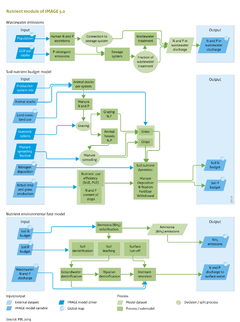Nutrients/Data uncertainties limitations: Difference between revisions
Jump to navigation
Jump to search
m (Text replace - "|Status=On hold" to "") |
No edit summary |
||
| (8 intermediate revisions by 4 users not shown) | |||
| Line 1: | Line 1: | ||
{{ComponentDataUncertaintyAndLimitationsTemplate | {{ComponentDataUncertaintyAndLimitationsTemplate | ||
|Reference=OECD, 2012; FAO, 2012a; Beusen et al., 2008; | |||
|Description=<h2>Data, uncertainties and limitations</h2> | |||
===Data=== | |||
The data stem from various parts of IMAGE, such as land cover, biomes, crop production and allocation, livestock, fertiliser use and nutrient excretion rates. Environmental data include temperature and precipitation, runoff, and soil properties (see Input/output Table [[Nutrients|Introduction part]]). | |||
External data are used in determining historical N excretion rates, manure spreading and fertiliser use efficiency, but their development in the future is a scenario assumption. Additional information used only in this section includes lithology, relief and slope of the terrain. Additional data used in the nutrient budget model include subnational data as used for the United States, India, Brazil and China. | |||
===Uncertainties=== | |||
With regard to uncertainties, the budget calculations and individual input terms for 2000 have been found to be in close agreement ([[Bouwman et al., 2009]]) with detailed country estimates for the member countries of the Organisation for Economic Co-operation and Development ([[OECD, 2012]]). | |||
However, uncertainty is larger for some budget terms than for others. Data on fertiliser use are more reliable than on N and P animal excretions, which are calculated from livestock data ([[FAO, 2012b]]) and excretion rates per animal category. Data on crop nutrient withdrawal are less certain than on crop production, because the withdrawal is calculated with fixed global nutrient contents of the harvested proportions of marketed crops. In addition to uncertainty in nutrient contents, major uncertainties arise from insufficient data, for instance, on crops that are not marketed and on the use of crop residues. This leads to major uncertainties about nutrient withdrawal. | |||
Sensitivity analysis ([[Beusen et al., 2015]]) of global nutriënt transport model with data for the year 2000 showed that: | |||
* runoff is a major factor for N and P delivery, retention and river export. | |||
* Uptake velocity and all factors used to compute the subgrid in-stream retention are important for total in-stream retention and river export of both N and P | |||
* Soil N budgets, wastewater and all factors determining litterfall in floodplains are important for N delivery to surface water. | |||
* For P the factors that determine the P content of the soil (soil P content and bulk density) are important factors for P delivery and river export. | |||
Sensitivities for the years 1900 and 1950 ([[Beusen et al., 2016]]) show that inputs from vegetation in floodplains (for N and P) and weathering (for P) are important in the first half of the 20th century, when human activites were not yet overshadowing natural sources of nutrients. | |||
}} | }} | ||
Latest revision as of 15:24, 2 November 2016
Parts of Nutrients/Data uncertainties limitations
| Component is implemented in: |
| Components: |
| Related IMAGE components |
| Projects/Applications |
| Key publications |
| References |
